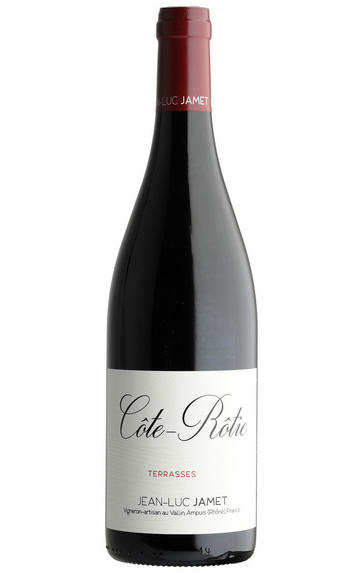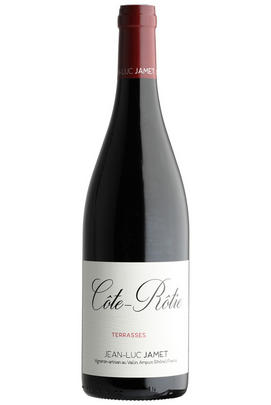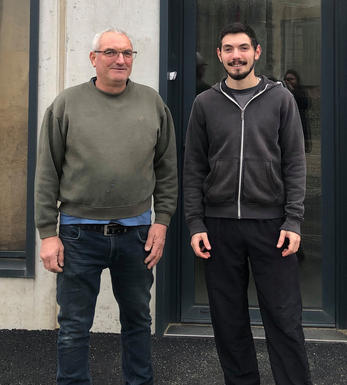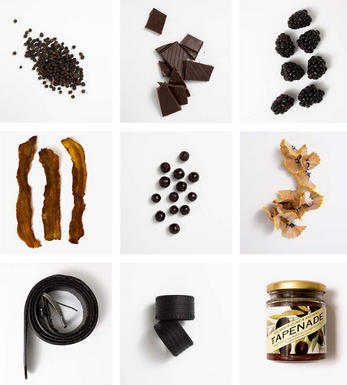
2019 Côte-Rôtie, Terrasses, Jean-Luc Jamet, Rhône

Critics reviews
Deep ruby. A mineral- and smoke-tinged bouquet evokes ripe black and blue fruits and liquorice; a floral nuance builds as the wine opens with air. It shows very good energy and spicy lift to its juicy boysenberry and bitter cherry flavours, which are complemented by suggestions of allspice, smoked meat and candied liquorice. It finishes long and taut, with repeating cherry notes, a chewy tannic grip and a jolt of spicy cracked pepper.
Drink 2026 - 2035
Josh Raynolds, Vinous.com (December 2022)
The 2019 Cote Rotie Terrasses features scents of mocha, black olives, toast and black cherries on the nose. It's nicely ripe and supple on the medium to full-bodied palate, finishing silky and elegant. It might lack the aromatic fireworks of some Côte Rôties, but it's a fine, down-the-middle example of the appellation.
Just a few steps up the hill and a solid stone wall apart from the old family domaine now home to his brother, Jean-Luc Jamet continues to build and expand his brand-new cellars. As it had been some time since my previous visit, we had some catching up to do, and we went through a few short verticals of the domaine's wines, as well as a quick barrel tasting of the lots destined for the 2020 Cote Rotie Terrasses.
Drink 2023 - 2035
Joe Czerwinski, Wine Advocate (January 2022)
The star of the show is the 2019 Côte Rôtie Terrasses, which can thought of as a hypothetical mix of the 2017 and 2018, with perhaps a nod to the 2017. Both red and black fruits, peppery herbs, dried flowers, graphite, and a beautiful sense of minerality define the bulk of the aromatics, and it's medium to full-bodied on the palate, with fine, building tannins, terrific overall balance, and a great finish. From a vintage that produced ripe, tannic wines, this stays balanced and pure and is loaded with potential.
Jeb Dunnuck, JebDunnuck.com (December 2022)About this WINE

Vignoble Jean-Luc Jamet
Jean-Luc Jamet worked for many years alongside his brother Jean-Paul at the family estate, Domaine Jamet, before setting off on his own in 2013. He now works a total of eight hectares with his son, Benoit: five hectares of Côte-Rôtie, two of Côtes-du-Rhône and one hectare of Vin de Pays. Currently undergoing extensive renovations, the estate can be found on the plateau at Le Vallin, an impressively windy drive above the slopes of the Côte Rôtie. His flagship wine is the Côte-Rôtie Terrasses and is receiving increasing interest – though his generic labels should not be over-looked. He is even experimenting with non-Rhône varieties under his IGP labels.
This is the second year running we’ll be offering Jean-Luc’s wines, following on from the success of last year. His 2020 Côte-Rôtie shows the concentration and intensity of this bold but elegant vintage, while his white showcases the acid structure and purity of the 2021s — both with plenty of personality and ageing potential.

Syrah/Shiraz
A noble black grape variety grown particularly in the Northern Rhône where it produces the great red wines of Hermitage, Cote Rôtie and Cornas, and in Australia where it produces wines of startling depth and intensity. Reasonably low yields are a crucial factor for quality as is picking at optimum ripeness. Its heartland, Hermitage and Côte Rôtie, consists of 270 hectares of steeply terraced vineyards producing wines that brim with pepper, spices, tar and black treacle when young. After 5-10 years they become smooth and velvety with pronounced fruit characteristics of damsons, raspberries, blackcurrants and loganberries.
It is now grown extensively in the Southern Rhône where it is blended with Grenache and Mourvèdre to produce the great red wines of Châteauneuf du Pape and Gigondas amongst others. Its spiritual home in Australia is the Barossa Valley, where there are plantings dating as far back as 1860. Australian Shiraz tends to be sweeter than its Northern Rhône counterpart and the best examples are redolent of new leather, dark chocolate, liquorice, and prunes and display a blackcurrant lusciousness.
South African producers such as Eben Sadie are now producing world- class Shiraz wines that represent astonishing value for money.


Buying options
Add to wishlist
Description
Terrasses is a blend of top lieux-dit parcels, including Lancement, Bonnivières and Landonne. The ’19 has an intense nose of black fruit, violets, and crushed graphite. In keeping with the vintage, it is juicy and well-structured, but tannins are fine and elegant, and there is a peppery precision to the finish that keeps this fresh. Extremely well-balanced.
Drink now to 2040
Georgina Haacke, Fine Wine Buyer, Berry Bros. & Rudd (March 2022)
wine at a glance
Delivery and quality guarantee